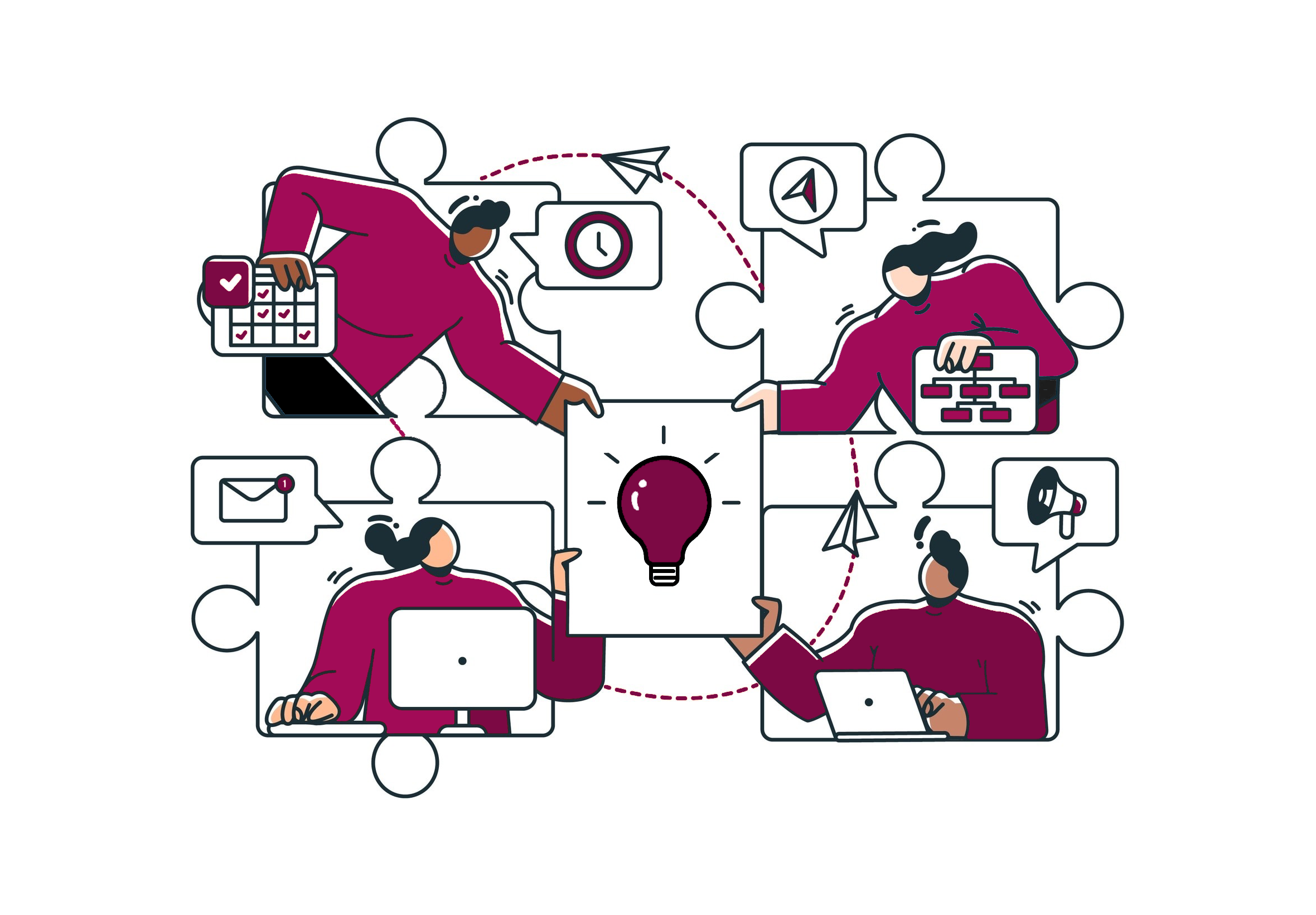Enterprise Integration Architecture in large scale organizations

Since the beginning of my ‘not so long’ career, enterprise integration has been on my radar due to its unique importance in an organization. In a business world that is constantly adapting and innovating, integration plays a major role in connecting systems seamlessly and enabling new features.
Just as a strong backbone relies on flexible joints, a healthy organization needs a robust integration layer designed and implemented thinking on future scalability and maintainability.
During my path in integration engineering, I observed organizations having a
diversity of integration tools, patterns and specialized teams, which can often result in diverse integration strategies. This fragmentation leads to knowledge silos, limited visibility of the integration assets, and inefficient duplication of efforts.
Just as a human body requires a clear strategy and defined goals for its joints and ligaments to connect bones effectively, organizations need a unified approach to integration. A well-design integration layer, where all components understand their role within a broader system, is essential for achieving organizational goals.
Finding a common ground for integration within an organization can offer significant benefits, yet it also presents unique challenges.
Gregor Hohpe and Bobby Woolf, authors of the seminal book “Enterprise Integration Patterns”, started documenting over 20 years ago with the goal of defining standards on how integrations can be designed and built to avoid having several different approaches for similar problems. Despite the passage of time, their insights remain relevant today as many companies are still trailing their path to achieve a consistent approach to integration.
How can we a achieve a well-designed integration layer?
By learning about the past while looking into the future…
The past is providing us experience and failures to reflect upon, while looking into the future (trends) is suggesting challenges we will need to face.
Enterprise Integration Architecture (EIA) lays a groundwork for designing, developing and exposing various systems. It encompasses several key aspects, such as strategy, architecture, standards, technologies, testing, monitoring, governance and discoverability.
In this article, I intend to provide an overview of key aspects of enterprise integration architecture (EIA) and how standards and best practices can help an organization achieve seamless connectivity.
1. Starting with a strategy …
Integration strategy is essential to guarantee that the design and developments done by the IT teams are aligned with the business goals.
To define a good integration strategy the initial discussions should be focused on the “Why” of an integration strategy.
– Why are we creating an integration strategy?
And only after this we start defining “How?”
– How will we achieve this integration strategy?
A good integration strategy relies on …
– Anticipating the organization’s future direction and potential challenges
– Building room for improvement and scalability
– Fostering open communication and alignment among teams
If we reflect upon these statements, we can avoid common pitfalls such as jumping into the design and developments without a clear strategy and context. In these scenarios, teams invest a great amount of time, yet the integration solution might not fit the business strategy or be ready to scale based on the upcoming business needs. In the end, this is bad for both the organization and the teams.
Defining a strategy usually lays on the enterprise architect responsibilities, since this role is focused on ensuring that the organization’s IT strategy is aligned with the business goals. The enterprise architect works closely with stakeholders and management to define the organization strategy.
2. Sliding into the “How?” of an integration strategy…
After defining the integration strategy, companies can approach other questions, such as:
– What will be the architecture of the integration assets?
– What are the common standards we want to set?
– Which technologies and tools fit best the requirements?
– How will we test and maintain the integration landscape?
– How will we govern the integration landscape?
– How will we promote discoverability of the assets available on the integration landscape?
These discussions are usually driven by integration architects together with enterprise architects. The integration architect responsibilities revolve around designing, implementing and maintaining the integration solutions that connect various software applications and systems within the organization.
a. Integration architecture
Integration architecture is focused on defining common building blocks and consistent data models to ensure interoperability between systems. The architecture of assets should have in consideration it’s reusability and scalability.
For example, when designing a new API that exposes customer information to an HR system, integration architects should conduct an analysis to understand its potential uses across the organization. Adopting a data-driven approach, rather than focusing solely on a specific system, ensures that the API can be easily leveraged by other applications requiring similar data.
Defining integration assets with the global view in mind improves asset reusability across the organization.
b. Standards
Integration standards are a set of guidelines, protocols and specifications that guide how different systems can communicate and exchange data.
Those standards should be defined based on the technical and business goals, existing organization infrastructure and systems, and state of the art best-practices for integration.
Ideally, we don’t want to fall into the trap of having several approaches on how to exchange data between systems.
For example, JSON can be defined as the preferred data format for exchanging data. By specifying this standard, teams will consider it on the design and implement it if possible.
Defining these standards within an organization will promote interoperability, data consistency, and overall system efficiency.
c. Technologies and Tools
An organization should also provide a comprehensive set of tools and technologies for integration, such as integration platforms and API management tools.
Choosing the right tool is dependent on evaluating the importance of certain features and capabilities, such as:
– Out-of-the-box connectors to abstract data sources and targets
– Data transformation
– Error handling and monitoring
– Data quality
– Security and compliance
– Supported integration patterns
– Cloud-Based vs On-premises vs Hybrid
– Tool usability
Besides capabilities, organizations also reflect upon budget, resources and vendor support. Large organizations often employ multiple integration tools to address diverse technical challenges and mitigate risks associated with vendor changes.
I believe that utilizing a diverse set of tools is very important for any organization. This approach fosters flexibility and adaptability, allowing the company and development teams to readily adjust to evolving needs. Besides, it helps mitigate risk of ‘technical dept’ scenarios and accumulation of hidden costs associated with the technological constraints of relying to a single software or tool.
d. Tests and Monitoring
A robust integration landscape requires a comprehensive testing and monitoring strategy to guarantee reliability, performance and security.
Usually, the testing strategy includes different stages, such as unit, integration, performance and security tests.
Real-time monitoring is used to analyze system health, resource usage, errors and logs. Alerts are often configured to guarantee timely notifications of critical issues.
e. Governance
Integration governance provides a framework for managing integration activities whithin an organization. It involves setting guidelines and best practices to streamline the integration process.
Companies often create a dedicated team of integration experts familiar with the various tools used within the organization. These type of commitees often define guidelines and provide consultancy to the IT teams reagarding integration topics. Governance comitees are key for prioritizing integration topics, maintain strategic focus and mitigate risks.
f. Discoverability
In large organizations, discoverability of integration assets can be a game-changer. Given the complexity of some organizational structures, visibility into existing assets can be challenging.
A centralized portal for discovering all integration assets is a powerful tool for promoting reusability, avoiding duplication of effort, and ultimately reducing costs and accelerating time-to-market.
3. Checking in and reflecting on metrics …
Even if an integration layer is well defined, a proactive approach on metrics can help detect inconsistencies and opportunities.
Monitoring an integration landscape is very important to ensure optimal performance, reliability and security.
A shared vision is fundamental to achieve a good integration layer. We might not yet know the exact needs of the business for tomorrow, but we can still build something that is versatile and can easily adapt to the demands of the future.





